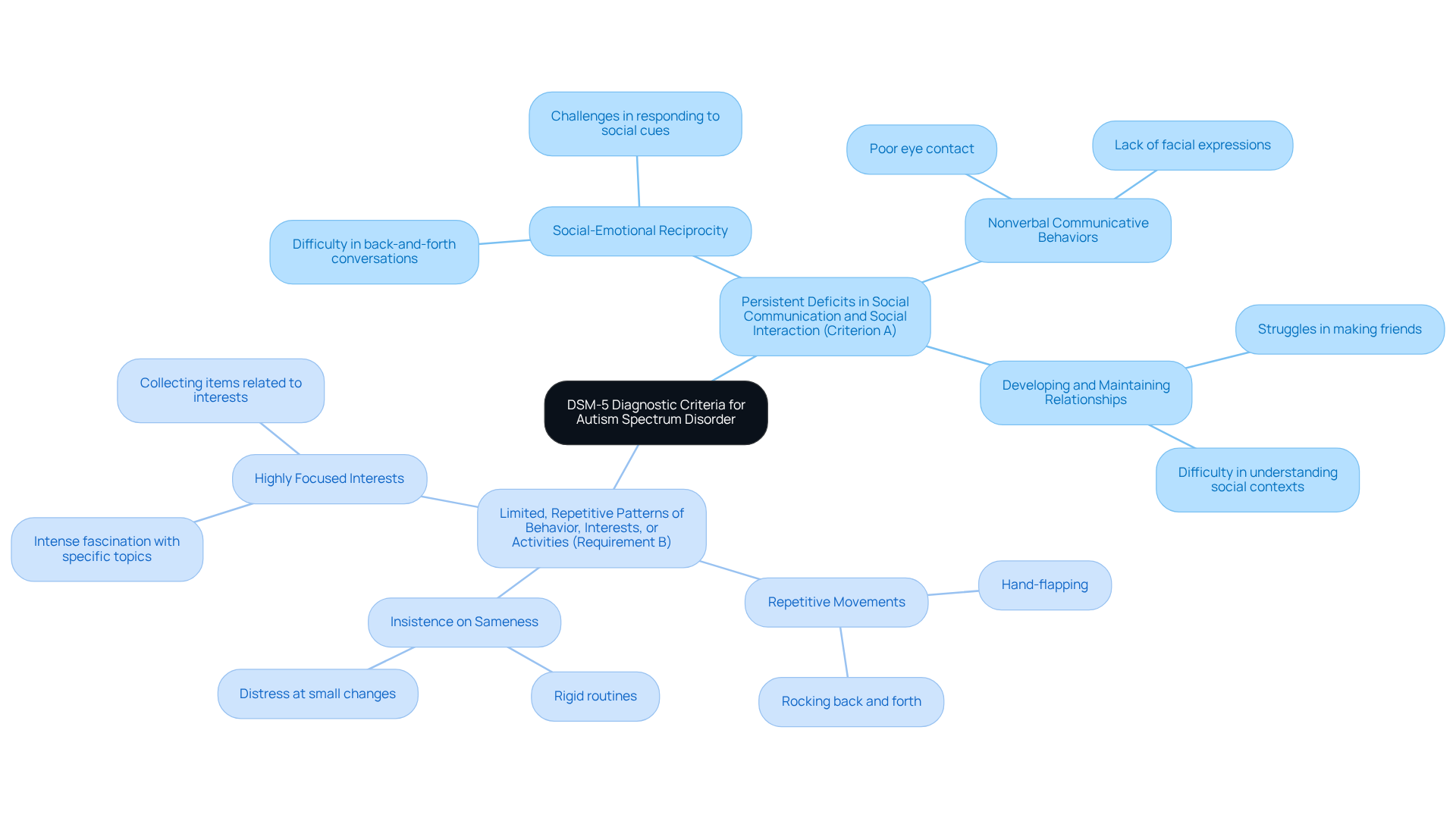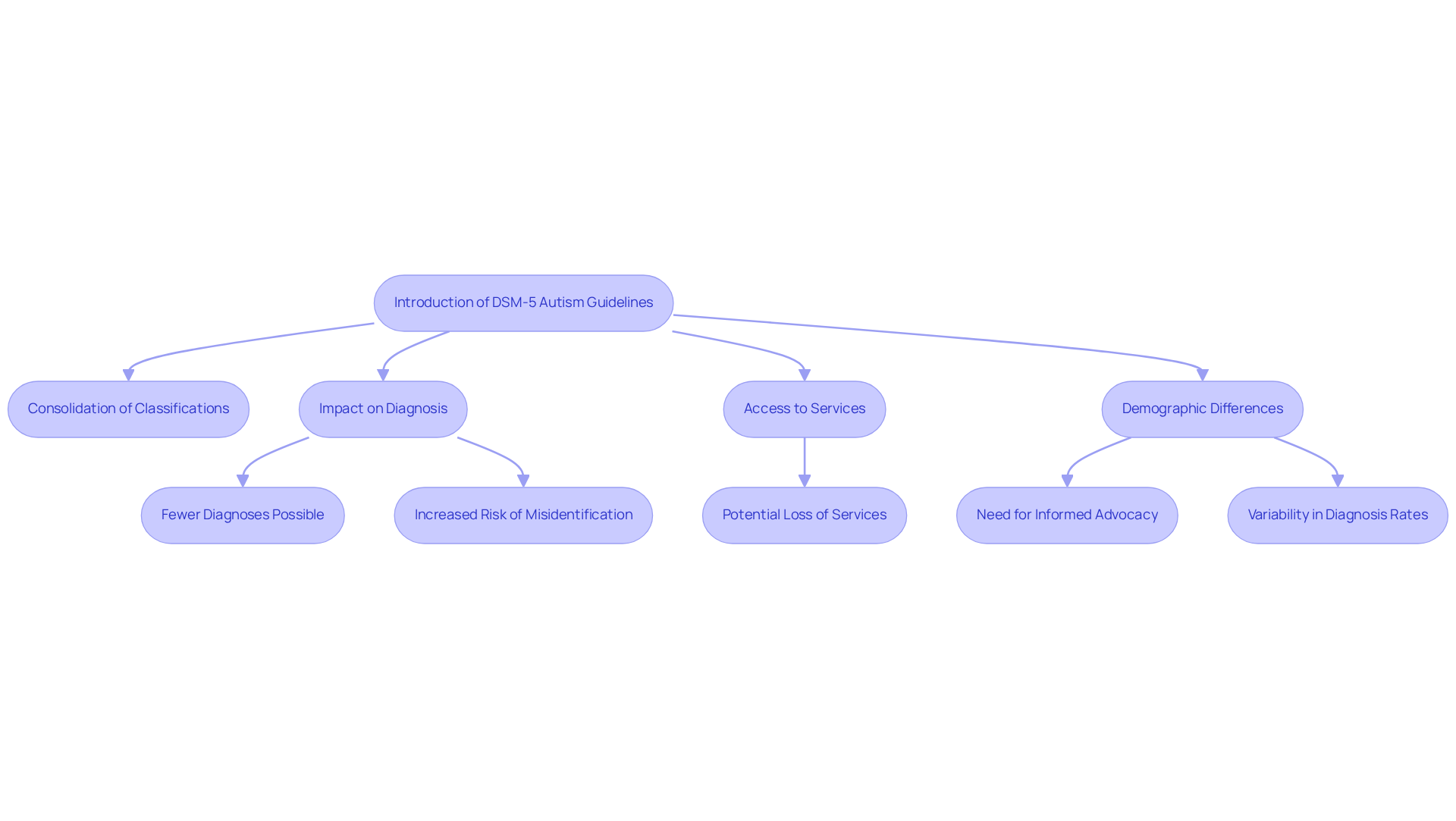Overview
This article delves into the essential criteria for Autism Spectrum Disorder (ASD) as outlined by the DSM-5, shedding light on the implications these criteria hold for diagnosis and support. By consolidating previous classifications into a single category, the DSM-5 not only facilitates accurate diagnosis but also enables tailored interventions that can truly make a difference in the lives of individuals with ASD. However, this shift also brings forth concerns about the potential misidentification of those who may not fully meet the new criteria, which can impact their access to necessary services.
Understanding these dynamics is crucial for parents and caregivers navigating the complexities of ASD. It’s important to recognize that while the DSM-5 aims to streamline the diagnostic process, it also underscores the need for continued advocacy and support for all individuals on the spectrum. By fostering open conversations and sharing experiences, we can work together to ensure that everyone receives the understanding and resources they deserve.
As we explore these criteria further, let’s remember that knowledge is power. By staying informed and connected, we can advocate for our loved ones and help them thrive in a world that sometimes feels overwhelming. Your experiences and insights matter—feel free to share them in the comments or through our newsletter, as we embark on this journey of understanding and support together.
Introduction
Understanding Autism Spectrum Disorder (ASD) is essential, especially as its prevalence continues to rise, affecting approximately 1 in 54 children. This growing reality can be overwhelming for many families. The DSM-5 autism manual stands as a vital resource for accurate diagnosis and tailored support, merging various classifications into a unified framework that reflects the spectrum's complexity.
In this article, we will explore the key criteria outlined in the DSM-5, examining how these criteria shape diagnosis and treatment strategies. We will also discuss the implications for individuals and families navigating the challenges of autism.
- How do these evolving standards influence access to essential services?
- What can we do together to ensure that all individuals receive the support they need?
Your experiences and insights are invaluable, and we encourage you to share them as we embark on this journey of understanding and support.
Define Autism Spectrum Disorder and the Role of DSM-5
Autism Spectrum Disorder (ASD) is a neurodevelopmental condition that presents enduring challenges in social communication and interaction, alongside restricted and repetitive behaviors. The DSM-5 autism manual serves as a vital resource for clinicians diagnosing ASD. By merging previously distinct classifications into a unified category, it highlights the spectrum nature of autism, which can manifest a diverse array of symptoms and severity levels. This framework is crucial for ensuring individuals receive tailored support and interventions that meet their unique needs.
The influence of the DSM-5 autism extends beyond mere diagnosis; it shapes treatment strategies and educational planning for those with autism. For instance, the introduction of a severity assessment scale categorizes individuals into three levels based on their support requirements:
- Level 1 (requiring support)
- Level 2 (requiring substantial support)
- Level 3 (requiring very substantial support)
This classification empowers clinicians to develop targeted interventions that align with each person's distinct challenges.
Understanding the role of the DSM-5 autism manual is essential for parents and professionals alike, as it not only facilitates accurate diagnosis but also informs effective strategies for managing behaviors and enhancing social skills development. The emphasis on early detection and intervention is particularly significant, as research indicates that timely support can lead to improved outcomes for those with autism. Moreover, the diagnostic manual introduces new observational criteria that allow for the diagnosis of individuals who may have shown early signs of autism, even if their symptoms only became apparent later in life. Challenges related to social-emotional reciprocity are also key in diagnosing autism, reflecting the intricate nature of social interactions faced by individuals with ASD. Additionally, sensory processing issues are recognized as a hallmark of autism, profoundly affecting daily experiences.
As the prevalence of autism continues to rise, with approximately 1 in 54 children diagnosed, the DSM-5 autism diagnostic manual remains an indispensable tool in navigating the complexities of autism diagnosis and treatment. Clinicians emphasize that understanding these standards is crucial for parents, educators, and healthcare professionals to ensure that individuals receive the support they need.
Explore DSM-5 Diagnostic Criteria for Autism Spectrum Disorder
Understanding Autism Spectrum Disorder can be daunting for many parents. The DSM-5 autism outlines specific criteria to assist in diagnosing this condition, which are categorized into two main groups that reflect the challenges your child may face.
The first category is Persistent Deficits in Social Communication and Social Interaction (Criterion A). This encompasses difficulties in social-emotional reciprocity, nonverbal communicative behaviors, and the ability to develop, maintain, and understand relationships. For instance, you might notice your child struggling to engage in back-and-forth conversations or having difficulty responding to social cues, which can be concerning.
The second category is Limited, Repetitive Patterns of Behavior, Interests, or Activities (Requirement B). This includes behaviors like repetitive movements, insistence on sameness, and highly focused interests. You may observe your child engaging in repetitive hand-flapping or being intensely fascinated by a specific topic, which can be both intriguing and puzzling.
To meet the diagnostic criteria, symptoms must be apparent during the early developmental phase and lead to significant disruptions in social, occupational, or other vital areas of functioning. Recognizing these standards is crucial for parents and professionals alike, as it allows for early identification of DSM-5 autism and the pursuit of appropriate interventions. If you find yourself relating to any of these signs, know that you are not alone, and there are resources available to help you navigate this journey.

Analyze the Implications of DSM-5 Criteria on Diagnosis and Support
The introduction of the dsm5 autism guidelines marks a significant shift in how we assess and support individuals with Autism Spectrum Disorder (ASD). This change consolidates previously separate classifications, like Asperger's syndrome and Pervasive Developmental Disorder-Not Otherwise Specified (PDD-NOS), into one category of ASD. While this may streamline diagnoses, it could also lead to fewer individuals being diagnosed under the new standards, which may impact their access to essential services and support.
Research underscores the importance of early identification, as timely intervention can greatly improve outcomes for children with autism. However, the complexity of the new standards might create challenges for healthcare providers, increasing the risk of misidentification or delays in diagnosis. For instance, studies indicate that at least 12% and possibly up to 40% of children currently classified in one of the PDD subgroups may be reclassified or lose their diagnosis under the new guidelines. Among children previously diagnosed with ASD, around 81.2% met the new diagnostic criteria, suggesting that many may experience changes in their eligibility for services.
Demographic differences also emerge, with studies revealing that 88.0% of Asian children met the ASD criteria compared to 78.1% of Hispanic children. This highlights the need to understand how diagnostic criteria impact various groups.
Parents and professionals must stay informed about these changes to effectively advocate for the necessary resources and support services. As Dr. Neal Halfon notes, "Many parents express concern that while it is difficult for schools to outright deny an autism assessment, the new ASD standards might lead schools to refuse services due to existing economic pressures."
Grasping the dsm5 autism criteria not only aids in accurate diagnosis but also informs the development of personalized intervention strategies, ultimately enhancing the quality of life for individuals with dsm5 autism and their families. The ongoing conversation surrounding these changes emphasizes the vital role of pediatricians and advocates in navigating the evolving landscape of autism care, especially as families face challenges during transitions between service systems. Additionally, ethical considerations regarding resource allocation remain a pressing concern, as finding a balance between accurate diagnostic tools and ensuring services for all affected children poses a challenge for healthcare providers and policymakers.

Conclusion
Understanding Autism Spectrum Disorder (ASD) is essential for fostering a supportive environment for individuals on the spectrum. The DSM-5 serves as a vital resource, offering a comprehensive framework for diagnosis while highlighting the diverse challenges faced by those with autism. By categorizing various classifications under one umbrella, the DSM-5 ensures that each individual receives the personalized support they need, leading to more effective interventions and educational strategies.
This article explores the specific diagnostic criteria outlined in the DSM-5, which focus on persistent deficits in social communication and repetitive behaviors. Recognizing these criteria is crucial for early identification, empowering parents and professionals to seek timely interventions that can significantly improve the quality of life for those affected. Moreover, understanding how these guidelines impact access to services underscores the importance of advocacy and informed support, especially for families navigating the complexities of autism care.
Ultimately, grasping the DSM-5 criteria for autism transcends mere diagnosis; it fosters an environment where individuals with ASD can truly thrive. As awareness of autism continues to expand, it is vital for parents, educators, and healthcare providers to stay informed and proactive. By embracing the insights offered by the DSM-5, we can better advocate for the necessary resources and ensure that every individual on the spectrum receives the compassionate support they deserve. Together, let us work towards a brighter future for all individuals with autism.
Frequently Asked Questions
What is Autism Spectrum Disorder (ASD)?
Autism Spectrum Disorder (ASD) is a neurodevelopmental condition characterized by enduring challenges in social communication and interaction, along with restricted and repetitive behaviors.
How does the DSM-5 relate to Autism Spectrum Disorder?
The DSM-5 serves as a vital resource for clinicians diagnosing ASD. It merges previously distinct classifications into a unified category, highlighting the spectrum nature of autism, which can present a diverse array of symptoms and severity levels.
What are the severity levels of autism according to the DSM-5?
The DSM-5 categorizes individuals into three severity levels based on their support requirements: Level 1 (requiring support), Level 2 (requiring substantial support), and Level 3 (requiring very substantial support).
Why is the DSM-5 important for treatment strategies and educational planning?
The DSM-5 influences treatment strategies and educational planning by providing a framework that allows clinicians to develop targeted interventions tailored to each individual's unique challenges.
What is the significance of early detection and intervention in autism?
Early detection and intervention are significant because research indicates that timely support can lead to improved outcomes for individuals with autism.
What new criteria does the DSM-5 introduce for diagnosing autism?
The DSM-5 introduces new observational criteria that allow for the diagnosis of individuals who may have shown early signs of autism, even if their symptoms only became apparent later in life.
What challenges are key in diagnosing autism according to the DSM-5?
Challenges related to social-emotional reciprocity and sensory processing issues are key factors in diagnosing autism, reflecting the complex nature of social interactions faced by individuals with ASD.
What is the current prevalence of autism diagnoses among children?
Approximately 1 in 54 children are diagnosed with autism, highlighting the importance of the DSM-5 as a tool in navigating the complexities of autism diagnosis and treatment.




